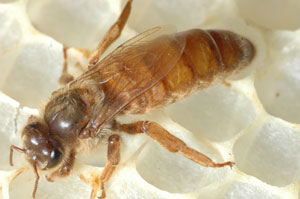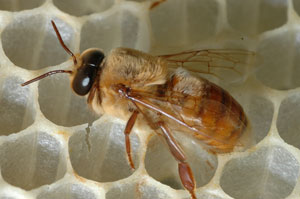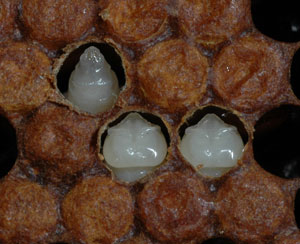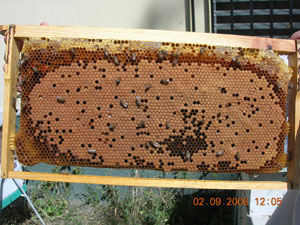Contents |
The Honey Bees’ World
It is safe to say that the bees’ agenda are not necessarily the beekeeper’s. The one is interested in securing a large honey supply to ensure the colony’s survival and ability to reproduce itself. The other is interested in securing a large honey crop to sell at the market. Both goals involve large honey supplies, but the beekeeper wants to accomplish this without permitting colony-level reproduction which is a road-block to maximum honey crops. A solid grounding in bee biology is necessary to be a successful beekeeper.
Social life
The agenda of a honey bee colony is this – to reproduce itself and survive next winter. A peculiarity of the honey bee and other social insects is that they have chosen a colonial life structure to help them do this.


Most people have an intuitive sense of what the term social insect means; there is something fundamentally different between a wasp colony in my carport and a cockroach family under my sink. By social insect entomologists mean a species that possesses all three of the following characteristics: (1) cooperative brood care, (2) reproductive division of labor, and (3) overlapping generations. By cooperative brood care we mean that females of the species share the burden of rearing the young, whether their own or others.’ Reproductive division of labor means that some individuals in the society abandon their own efforts at reproduction in favor of helping their sisters reproduce. By overlapping generations we mean that some offspring remain at the nest to help their parents rear more siblings. All these criteria imply that the society is living together in a shared nest, and in fact the ability to “nest” or habitually return to a specific shelter would appear a prerequisite to social behavior. In nature it is possible to find species that exhibit only one or two of the three defining characteristics, but one that possesses all three simultaneously for at least part of the year is termed truly social, or eusocial. All species of honey bees are eusocial, as are all termites and ants. Bumble bees are considered primitively eusocial because they achieve a truly social state only after the solitary overwintering queen rears her first batch of brood in early spring. Wasps display a range of life histories from solitary to eusocial
All this means that when we discuss honey bee biology it must be discussed on two levels: the individual level and the colony level. Individuals reproduce, develop, interact with their environment in a way to optimize survival, senesce, and die. So do colonies. It just looks different.
The biology of individuals

There are three types of individuals in a honey bee colony: female workers, female queens, and males often called drones (Figures 1-3). The fact that there are two different types of female is an example of what is called a caste – a functionally different form of the same sex. One often reads that workers, queens, and drones constitute three honey bee castes. This is not true; they constitute two sexes, the females of which are divided into two castes.
Some things in common


The three types of bees share some fundamental characteristics. Bees, as members of Class Insecta, share with other insects a body plan comprised of three major regions: the head, thorax, and abdomen. The head houses a large share of the sensory organs, chief of which are the eyes and antennae, as well as the mouth parts comprised of sucking parts (together called the tongue) and chewing parts. The middle body region, the thorax, houses the locomotory appendages, the legs and wings, and the muscles for powering them. The abdomen is the chief repository for organs of digestion and reproduction.

Bees belong to that group of insects that engage in complete metamorphosis – that is, insects in which an individual passes through four developmental stages: egg, larva, pupa and adult. In the case of honey bees, the queen deposits an egg singly in the bottom of a beeswax cell (Fig. 4a). The egg is sausage-shaped, about 1/16-inch in length, and hatches after three days into the larva, or feeding stage. The larva is an undistinguished white grub and quite active although this movement is undetectable to a casual observer (Fig. 5). As worker bees place food in its cell, the larva moves forward to consume it; hence, the larva adopts a C-shaped posture during its feeding career. A few days later when the feeding phase is over the larva enters an intermediate stage known as the prepupa (Fig. 6); the larva elongates to fill most of the cell, workers cap the cell with beeswax, and internal changes begin which result in the prepupa’s transformation after a few hours into a quiescent white pupa (Fig. 6). The pupa looks superficially like an adult. The three major body regions become apparent for the first time, but there is no pigmentation, hair or wings, and the individual moves little or not at all. In the remaining days of development, the pupa darkens gradually and develops hair and wings and after a few days chews through its cell capping and emerges as an adult (Fig. 1). In general the number of days from egg to adult is 21 for the worker, 24 for the drone and 16 for the queen, but these numbers vary by race and location. Worker cells are by far the majority, tend to occupy the central regions of a comb face, and have uniformly flat cappings (Fig. 7). Drone cells are larger in diameter, the cappings more rounded or bullet-shaped (Fig. 8), and patches of drone brood tend to concentrate toward the bottom edges of combs. Queen cells are the least numerous, totaling at most around 20 per colony. They are the size and shape of a peanut and comprise the only brood cells oriented in a vertical posture relative to the comb face (Fig. 9).
The biology of workers


Of the three bee types, workers are the most numerous, behaviorally diverse and interesting. It is workers that care for the queen, feed the brood, clean and defend the nest, forage for food, recruit nestmates to food sources and make the kind of decisions popularly ascribed to the queen. For example it is workers, not the queen, who determine the types of resources – protein, carbohydrates, propolis or water – needed by the colony and communicate that fact to the workers engaged in foraging. Similarly it is workers, not the queen, who decide if and when the colony reproduces – a complicated process called swarming.
Just as they are the most behaviorally complex, workers are the most anatomically complex. To carry liquid loads of nectar or water, workers suck up liquids into their honey stomach – the first chamber of a three-chambered stomach, and regurgitate their loads back at the nest. On their hind legs they have a complicated structure called the pollen basket in which they carry pollen loads. The most famous worker anatomical specialization is their persuasive sting assembly comprised of a venom gland and barbed stinger. Glands occur on other parts of the body for producing brood food, beeswax, and pheromones – external hormones that regulate the behavior of other bees. It should come as no surprise that workers, not the queen or drones, have the greatest cognitive powers, displaying remarkable ability to exchange information, learn, make decisions and navigate.

As one of the two female castes in the honey bee colony, workers have functional ovaries and are capable of producing eggs and progeny. However, workers are not capable of mating, and in the ants, wasps and bees this condition results in eggs that have half the normal number of chromosomes which, in turn, results in progeny that are exclusively male. In a normal colony with a queen (called queenright), this type of worker reproduction is limited by the interaction of queen pheromones and brood pheromones that collectively suppress activation of worker ovaries. But in queenless colonies there is no such pheromonal suppression, and a condition of laying workers results. Workers are notoriously poor egg-layers, and they deposit eggs either multiply or singly in an irregular pattern inside cells (Fig. 4b).
The biology of queens

In the beginning, any female egg has the potential to develop into either a queen or a worker. It all depends on the kind of diet the young larva receives after it hatches. If the colony wishes to rear queens, nurse bees choose one or more young female larvae and begin feeding them a special glandular secretion called royal jelly which triggers development of queen-like characters. This window of opportunity is brief. The larva must begin its royal jelly diet within a few hours of hatching and continue the diet uninterrupted its whole larval feeding career. There is a direct relationship between the duration of the royal jelly feeding regimen and quality of queen that results. A queen whose royal jelly diet is delayed or truncated will be sub-optimal in her queen-like morphology and performance. In controlled laboratory feeding conditions it is possible to rear bizarre intercastes – individuals with varying degrees of worker-like or queen-like traits simply by varying the days spent on royal jelly. In a normal situation, the female larva experiences accelerated growth, and the nurse bees accommodate this by enlarging the larva’s cell into the typical vertical peanut shape. The royal jelly triggers development of queen-like characters such as full-sized ovaries, the ability to mate and store sperm, and glands for producing queen pheromones.

Within the first two weeks of life, a newly-emerged queen takes a succession of mating flights during which she mates with up to twenty drones on the wing. She is able to store their sperm in an organ called the spermatheca over which she has muscular control to release, or withhold sperm. As an egg passes down her median oviduct, the queen can fertilize it and produce a female, or withhold fertilization and produce a male. The egg-laying proficiency of queen bees is legendary, with numbers up to 1500 per day not uncommon (Fig. 10). The ability to fertilize eggs seems to deteriorate in aged or failing queens, with the result being a disproportionately large amount of drone brood in the colony, intermixed in uncharacteristic fashion with worker brood (Fig. 11).

Almost equal in importance as her eggs are a queen’s pheromones. I’ve already mentioned one function of queen pheromone, partial suppression of worker ovaries, but these chemical are also responsible for stimulating foraging, prolonging worker life, and coordinating swarms during colony reproduction. Workers constantly lick and groom the queen, pick up her pheromones and pass them on to other workers. In this manner, queen pheromone is constantly circulating throughout the colony exerting its profound behavioral and physiological effects on the inmates. This stabilizing effect is easily demonstrated when a beekeeper removes a queen; the colony shows visible signs of agitation within 30 minutes.
The biology of drones

In explaining immature development and the mating behavior of queens I have almost by default exhausted the biology of drones. Yes, what you’ve heard is true. Drones are good for little besides mating with queens. Drones stay in their natal colony for the first couple weeks of life, living off the largesse of nest bees before reaching maturity at which point they begin participating in daily afternoon flights. These tend to be gregarious affairs in which large numbers of drones from numerous colonies pool together to fly in a comet-like mass around the neighborhood. The paths followed by these drone comets tend to be the same year after year and are associated with permanent landmarks such as prominent trees, hedgerows and the edges of forests. Some beekeepers have made a life hobby of monitoring drone congregation areas (Fig. 12). The persistence of drone congregation areas is especially distinctive when one considers that short-lived drones have no chance for inter-generational learning, as for example with salmon who are spawned in the same pool as their parents. Young queens on their mating flights seek out drone congregation areas and fly through them, inciting a frenzied chase during which she copulates with several drones. It is apparent that drone congregation areas are an effective strategy for both drones and queens to optimize mating success.
Back to table of contents for First Lessons in Beekeeping: Honey Bee Biology
Source:
The above is from “First Lessons in Beekeeping” by Keith S. Delaplane, reproduced with permission by the publishers Dadant & Sons, Hamilton, Illinois, USA, Copyright, 2007. This book can be purchased in its entirety from Dadant & Sons
